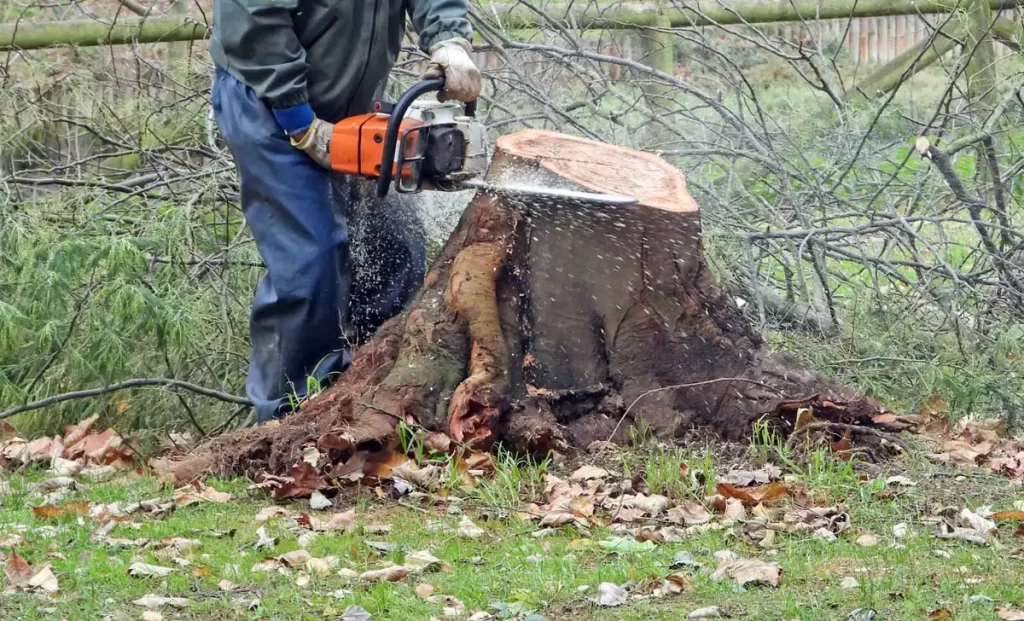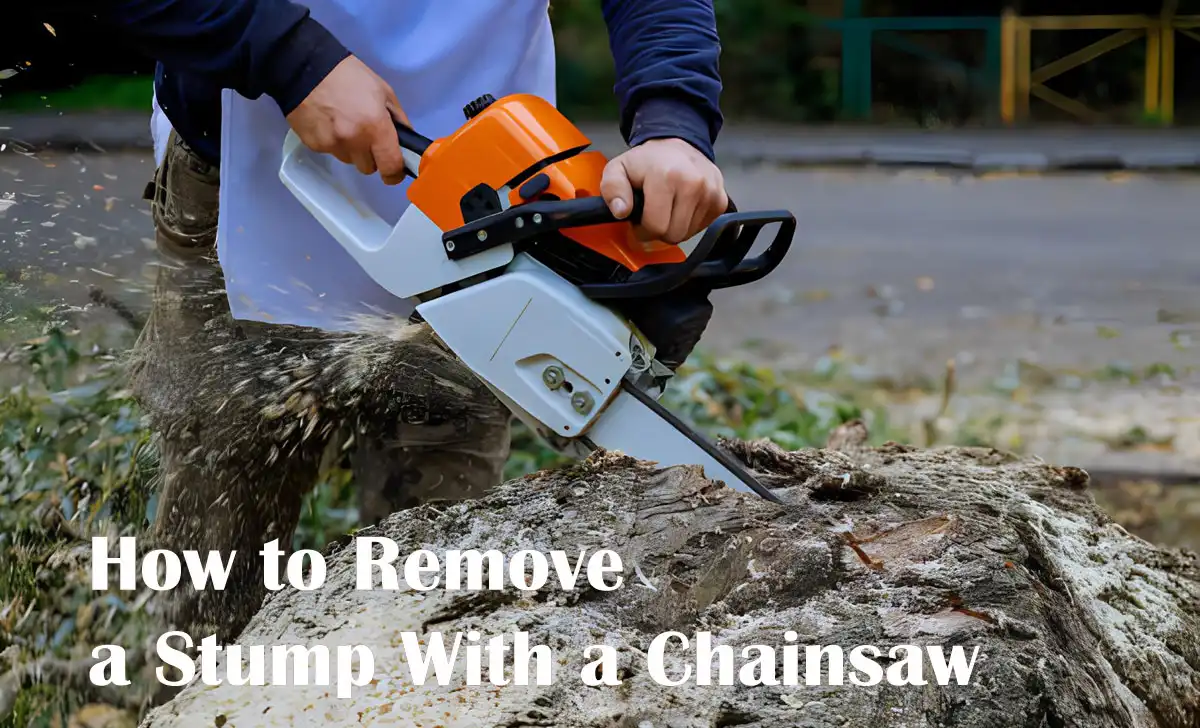To remove a stump with a chainsaw, cut the stump as close to the ground as possible, then make additional cuts into the stump’s surface to facilitate easier removal. Avoid cutting into the dirt to prevent chainsaw damage.
Removing a stump from your property might seem daunting, but with a chainsaw and the right technique, you can tackle the job with ease. Tree stumps can be unsightly and even hazardous, often requiring prompt action. Many homeowners opt for the DIY approach to stump removal, where a chainsaw becomes an invaluable tool.
By following safety precautions and employing a strategic cutting method, you can effectively cut away at the stump, making it manageable for complete extraction or further decomposition processes. Not only does this enhance your yard’s appeal, but it also prepares the land for new growth or alternative landscaping plans. Whether you’re clearing the way for aesthetic reasons or practical use, chainsaw stump removal offers a direct and cost-effective solution.
About Stump Removal
Removing a stump is often necessary after tree removal. This process can transform your landscape and reopen space for new projects. Whether due to aesthetic reasons, safety concerns, or to prevent pests and diseases, stump removal is a task that many choose to undertake.
Understanding the Basics of Stump Removal
Ridding your yard of a stump begins with understanding the task at hand. A stump consists of the tree’s above-ground base and root system. Its removal involves cutting it down as close to the ground as possible and then digging out the roots or using specialized machinery to grind or pull out what remains.
Benefits of Using a Chainsaw for Stump Removal
- Speed: Chainsaws can make quick work of a stump, cutting down the removal time.
- Precision: They allow for precise cuts, minimizing the workload.
- Accessibility: Chainsaws are readily available and simple to operate.
- Cost Savings: Using a chainsaw can be more cost-effective than renting large machinery.
Safety Considerations Before Starting
Safety first! Before starting, ensure you have the following safety gear:
| Safety Gear | Reason |
|---|---|
| Goggles | To protect eyes from flying debris |
| Gloves | For grip and hand protection |
| Ear Protection | To guard against loud noise |
| Boots | For foot safety and stability |
Also, clear the area of objects and ensure the chainsaw is in good working order. Always read the chainsaw’s manual and follow the manufacturer’s safety instructions.

Preparing For Remove a Stump With a Chainsaw
Removing a stump can transform your yard. To ensure success, preparation is key. Here’s how to get ready:
Assessing the Size and Type of the Stump
First, inspect the stump. Size and wood type impact removal. Note stump width and tree species to determine the effort needed.
Selecting the Right Chainsaw for the Job
Choose a chainsaw that is up to the task. Consider bar length and engine power. A powerful chainsaw makes the job easier.
Gathering Additional Necessary Tools and Equipment
- Safety gear: gloves, goggles, boots
- Sharpening tools for chainsaw
- Axe or digging bar
- Shovel for debris removal
Prepare tools for a smooth stump removal.
Clearing the Area Around the Stump
Clear rocks, debris, and equipment around the stump. Ensure ample space for safe chainsaw use. This step reduces risks and improves access.
Guide To Remove a Stump With a Chainsaw
Removing a stump from your property need not be a daunting task. With a chainsaw, you can turn this seemingly tough job into a doable DIY project. Follow this simple guide to make the stump disappear with ease.
Starting the Chainsaw and Approaching the Stump
First, safety is key. Equip yourself with protective gear: gloves, goggles, and ear protection. Check the chainsaw’s fuel and oil levels. Start it according to the manufacturer’s guide. Keep the chainsaw on the ground, engage the chain brake, then pull the starter rope. Approach the stump confidently but cautiously.
Making the Initial Cuts Into the Stump
Stand firmly with your feet apart. Plan your cuts to avoid kickback. Begin with horizontal cuts at the top of the stump. Aim to remove large, manageable sections. Avoid cutting into the dirt, which can dull the chain. Adjust the depth of the chainsaw blade to a comfortable level, usually a few inches.
Sectioning the Stump for Easier Removal
- Continue adding vertical cuts alongside the initial horizontal ones.
- Create sections like a pie chart.
- Break the stump into pieces, making them easier to lift and discard.
Drilling Holes to Aid in the Stump Removal Process
For larger stumps, drill holes in a grid pattern using a large bit. This technique assists with two aspects:
- It reduces overall stump mass to clear.
- It can serve as points for applying stump removal chemicals, if desired.
Finishing the Cut and Removing Root Structure
Work carefully around the roots. Undercut the stump as much as possible. Sever principal roots with the chainsaw, then use a shovel and axe for complete removal. Clear away the debris, fill the hole with soil, and compact it down.
Post-removal Procedures
Successfully removing a stump with a chainsaw is just the first step. Post-removal procedures are crucial for a clean, safe, and tidy area. Follow these steps to ensure everything is taken care of properly.
Disposing of the Stump Remnants
Once you’ve removed the stump, you’ll need to deal with the leftovers. Stump remnants can be handled in multiple ways:
- Compost: Break down smaller pieces for your compost heap.
- Yard Waste: Place in your yard waste bin if your waste management allows it.
- Landscape Material: Repurpose usable wood chips as mulch.
- Removal Service: Contact a local waste removal for larger pieces.
Cleaning the Chainsaw and Other Equipment
Maintain your tools for their longevity. Cleaning your chainsaw and equipment involves:
- Disassemble the chainsaw following the manufacturer’s guide.
- Clean each part with appropriate tools and solutions.
- Inspect for any damages and wear.
- Reassemble the chainsaw carefully.
- Store in a dry, safe location.
Repairing the Landscaping After Stump Removal
The area might look bare after a stump is gone. Repairing the landscape brings life back to your yard.
| Step | Action |
|---|---|
| 1 | Fill the hole: Use a mix of soil and compost. |
| 2 | Seed or Sod: Plant grass or lay sod over the area. |
| 3 | Water: Keep the new grass moist until established. |
Learn more: How Tight Should a Chainsaw Chain Be
Safety and Maintenance Tips
Removing a stump with a chainsaw involves risks. It requires strict adherence to safety protocols and equipment maintenance. Here’s your guide to staying safe.
Regular Chainsaw Maintenance For Safe Operations
Keep your chainsaw in top condition with these tips:
- Check the chain tension before starting and after every hour of use.
- Clean the air filter regularly to prevent dust from clogging the engine.
- Inspect the spark plug for deposits and replace it when necessary.
- Lubricate the bar and chain to reduce friction and prevent premature wear.
- Sharpen the chain for efficient cutting and to reduce the risk of kickback.
Personal Protective Equipment (ppe) To Use
Wear the right PPE to protect yourself:
| PPE | Function |
|---|---|
| Chainsaw Helmet | Shields head from flying debris |
| Eye Protection | Prevents sawdust from entering eyes |
| Hearing Protection | Reduces noise-induced hearing loss |
| Gloves | Improves grip and protects hands |
| Chainsaw Chaps | Guards legs from accidental cuts |
| Steel-toe Boots | Protects feet from falling objects |
Avoiding Common Mistakes and Accidents
Avoid accidents with these measures:
- Secure the stump to prevent movement while cutting.
- Work during daylight or in well-lit conditions for visibility.
- Never cut alone in case you need immediate help.
- Avoid using a dull chain, as it requires more force and can slip.
- Keep bystanders away to prevent injury from flying debris.
Conclusion
Removing a stump with a chainsaw can be efficient and cost-effective. It requires safety precautions, the right technique, and patience. By following the steps outlined in this guide, homeowners can tackle this task with confidence. Remember to maintain your chainsaw, wear protective gear, and never rush the process.
With attention to detail, that stubborn stump will soon be history, clearing the way for a pristine lawn or garden. In the world of chainsaws, there’s always something new, and Chainsaw Hive is where you’ll find it. Our Knowledge category is your go-to for the latest and greatest. Stick with us – you won’t regret it!
